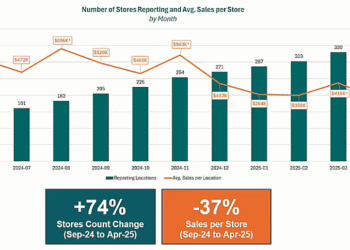The Ohio Department of Commerce’s decision to allow medical cultivators to use their own discretion in determining how much of their medical supply they convert to non-medical allowed for a relatively smooth start to adult-use sales, at the expense of price hikes for medical patients.
The state approved 98 dispensaries with certificates of operation on Aug. 6, effectively launching its adult-use market, which the state refers to as “non-medical,” roughly two weeks after the first non-medical cultivators and processors were approved and a month before the statutory deadline.
Every dispensary was originally a medical shop that was permitted to convert to a hybrid model serving medical and non-medical patients. In the first week of sales, those dispensaries pulled in $11.5 million from adult-use consumers, according to the Ohio Department of Commerce, which oversees the Division of Cannabis Control (DCC).
“A big reason we were able to get to this point ahead of the Sept. 7 deadline was due to the foundation laid through the state’s existing Medical Marijuana Control Program,” said DCC Superintendent James Canepa, in a released statement. “Since existing licensees had already met stringent requirements of that program, we anticipated this process to be rather smooth. They had already undergone many of the comprehensive checks as part of that process.”
DCC opened the market less than a month after the first cultivators and processors were granted non-medical licenses in late July. If those cultivators were required to wait for that approval before they could put non-medical plants in the ground, the entire adult-use market would have been delayed simply based on how long it would take to grow, trim and cure the bud.
“Dispensaries must ensure ongoing inventory sufficient to maintain an adequate supply of medical marijuana to meet the current demand and projected patient and caregiver population,” said James Crawford, DCC spokesperson. “It is up to each dispensary to determine what amount of supply meets that requirement for them.”
In a previous interview, Crawford noted that non-medical dispensaries were not allowed to sell product unless it had only been touched by non-medical licensed cultivators, processors and labs. But the stipulation does not prevent the sale of non-medical cannabis that was planted before its cultivator received the proper license, as long as that license was eventually obtained.
For example, Cresco Labs (CRLBF) reportedly put about 1,000 plants into the ground intended for the non-medical market before they officially received their certificate of operation, which happened on July 24.
Patients face sticker shock
While sales were booming across the state, medical patients were facing sticker shock, according to Ohio medical patient advocate Lorrie Prince-Callahan.
Ohio had more than 162,000 active medical patients as of July 25. Many of those patients have seen a spike in prices since adult-use sales began, said Prince-Callahan.
“It’s only been a week since they rolled it out, and prices are back to where they were when the medical program started. There are certain patients that have discounts [because] of their indigent or military status, but it’s too expensive,” she said. “We also have home grow here, which is another reason that a lot of us patients are staying away from the dispensaries right now.”
While most states with legal cannabis markets allow shops to sell in increments of grams, or eights, quarters or halves of ounces, Ohio dispensaries sell in tenths, fifths and halves.
The average price for a tenth of an ounce in the medical market last December was $16.93, down from about $31 a tenth when the medical market launched in January 2019, according to state data. Those prices jumped back up to between $25 and $35 per tenth, based on currently listed prices online for Ohio dispensaries. Non-medical patients are seeing similar price points, with the key difference being the tax rates between both categories of product.
Non-medical purchases incur a 10% excise tax that medical is exempt from, but both products are also subject to the state’s 5.75% sales tax and local tax.
In comparison, a tenth in Michigan would cost about $9.70 based on the average price of an ounce in July, according to the Michigan Cannabis Regulatory Agency’s latest monthly report.
“There are a ton of patients that are still going to Michigan,” said Prince-Callahan.













